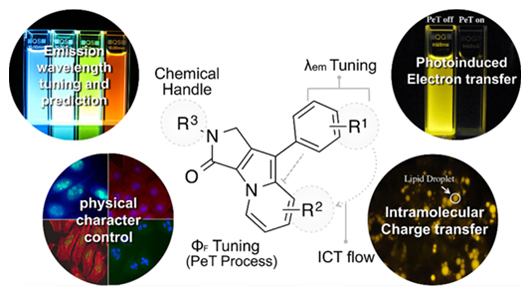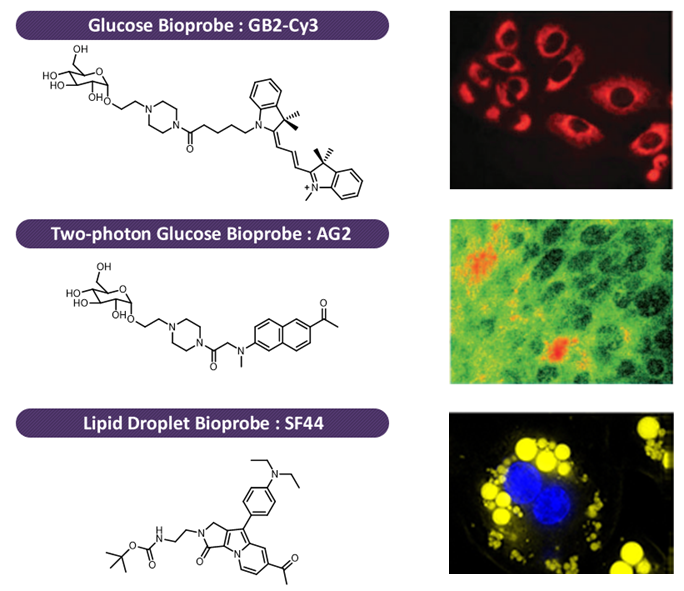SEOUL-FLUOR
- How we discover phenotypic changes
- Fluorescence molecules have been used for various scientific researches, such as visualization tools for cellular systems or diagnostic sensors for the disease relevant phenomenon. We have synthesized a series of novel fluorescent small molecules, called “Seoul-Fluor (SF)”, and elaboratively design them as a series of bioprobes to monitor various biological events.
Seoul-Fluor systems have intriguing advantages compared to conventional fluorescent molecules. First, SF shows tunable and predictable emission color covering a full visible-color range, so we can easily tune the color of molecule, depending on our research purpose. Second, SF has controllable brightness via so-called photo-induced electron transfer phenomenon, which can be linked to the rational development of biological sensors or diagnostic molecules. Third, they have environment-sensitive properties, in other words, their fluorescent color or brightness can be changed depending on the surroundings, which is very useful property to develop fluorescence-based screening systems.

We convincingly developed valuable fluorescent reporters or chemical sensors, which is highly useful tools for biological researches. We successfully constructed robust image-based high-contents screening in living cell, to find the potential drug candidates.
SF fluorescent molecules will play an important role in monitoring the invisible micro- and macro-worlds in life-sciences, and it will be guided us to finding new therapeutic candidates to tackle various diseases.

Publications
-
1.
Monochromophoric Design Strategy for Tetrazine-based Colorful Bioorthogonal Probes with a Single Fluorescent Core Skeleton. Lee, Y.; Cho, W.; Sung, J.; Kim, E.*; Park, S.B.* J. Am. Chem. Soc., 2018, 140, 974–983
-
2.
A High-Content Screening Platform with Fluorescent Chemical Probes for the Discovery of First-in-class Therapeutics. Jo, A.†; Jung, J.†; Kim, E.; Park, S.B.* Chem. Comm. 2016, 52, 7433–7445
-
3.
Discovery, Understanding, and Bioapplication of Organic Fluorophore: A Case Study with an Indolizine-Based Novel Fluorophore, Seoul-Fluor. Kim, E.; Lee, Y.; Lee, S.; Park, S.B.* Acc. Chem. Res. 2015, 48(3), 538–547.
-
4.
Rational Improvement of Molar Absorptivity Guided by Oscillator Strength: A Case Study with Furoindolizine-based Core Skeleton. Lee, Y.; Jo, A.; Park, S.B.* Angew. Chem. Int. Ed. 2015, 54(52), 15689–15693.
-
5.
Phenotypic Screening to Identify Small-Molecule Enhancers for Glucose Uptake: Target Identification and Rational Optimization of Their Efficacy. Koh, M.; Park, J.; Koo, J.Y.; Lim, D.; Cha, M.Y.; Jo, A.; Choi, J.H.; Park, S. B.* Angew. Chem. Int. Ed. 2014, 53(20), 5102–5106.
-
6.
Rational Perturbation of the Fluorescence Quantum Yields in Emission-tunable and predictable Fluorophores (Seoul-Fluors) by a Facile Synthetic Method Involving C-H Activation. Choi, E.; Kim, E.; Lee, Y.; Jo, A.; Park, S. B.* Angew. Chem. Int. Ed. 2014, 53(4), 1346–1350.
-
7.
Discovery of Autophagy Modulators through the Construction of a High-Content Screening Platform via Monitoring of Lipid Droplets. Lee, S; Kim, E.; Park, S.B.* Chem. Sci. 2013, 4(8), 3282–3287.
-
8.
Emission Wavelength Prediction of a Full-Color-Tunable Fluorescent Core Skeleton, 9-Aryl-1,2-Dihydropyrrolo[3,4-b]indolizin-3-one. Kim, E.; Koh, M.; Lim, B.J.; Park, S.B.* J. Am. Chem. Soc. 2011, 133, 6642–6649.
